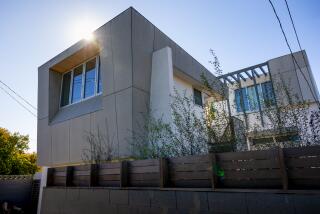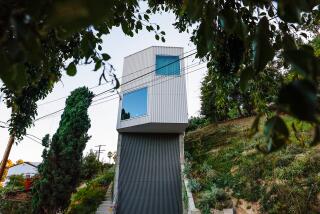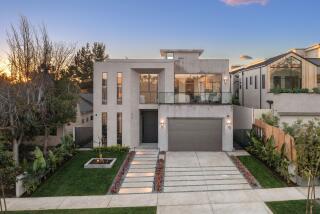What was once a mobile home is now just a special delivery.
Most people building custom homes donât have to think in 13 1/2-foot blocks, but Pamela and John Franks did. Their 2,750-square-foot home was created out of five factory-manufactured units that fit together like a giant jigsaw puzzle.
The Frankses, who moved into their home in May, decided on a manufactured house after searching without any success for affordable housing with a view near his motherâs home in Leisure World in Laguna Hills. In July 1994, they bought a vacant lot in a San Clemente mobile home park that overlooked a golf course and the Pacific Ocean and began designing their home using computer software.
âWe could have made each unit 120 feet long as long as it wasnât wider than 13 feet, 6 inches because thatâs as wide as you can get on the freeway,â John Franks says.
âThe design at first was a comedy of errors because we didnât understand we had to stay within the modular. We had bathtubs hanging out the side. Once we understood how everything had to be compartmentalized, we were able to decide where everything in the house would go,â he says.
The Frankses commissioned Silvercrest in Corona to make the home units, even though the company had never built a five-module house before. Working with special projects manager Steve Truslow, the couple settled on a design that used two horizontal modules for the front and three vertical modules for the back.
Installation began in September. On the first day, the two front units were delivered. They put rollers or tiny wheels under them by a complex system of pulleys and cables that allowed them to hand-pull these units down metal ramps. They were pulled into position and then joined together.
The remaining three units were installed the same way over three days.
After the units were put in place, state-of-the-art support systems by Suresafe Industries were added, using 16,000 pounds of concrete and 128 separate foundational piers.
This house, which Franks says is the largest manufactured one, is a long way from the mobile homes of yesteryear.
The Franksesâ house wonât be moving anywhere unless the whole hill goes with it.
*
Since the federal government began regulating the industry in 1976, manufactured houses are longer lasting and less mobile. In 1980, Congress changed all references from âmobileâ to âmanufactured.â
The main lure of manufactured housing is economic.
The average cost is $27 to $40 a square foot, compared to $100 to $180 for a conventional custom home. Modules have 6-inch-thick walls and 10-foot-high ceilings, which often cost extra in other homes.
âWe used all state-of-the-art systems in here,â Franks says. âAction Air did the air conditioning with two special filtration systems, one for the front and one for the back. Audio Video Today did all of the electronics with a central system and wall speakers throughout the house. Telecom did the specialized amplifier system. We can even have 60 different phones of any combination in the house.â
Franksâ eyes light up when he talks about the electronics in the house. The outdoor awnings can be electronically controlled by remote from inside the house; the sound on the television and stereos can be moved from room to room and lowered or raised by remote control. He even installed an electric lift in the garage instead of stairs, which would take up too much valuable space.
Another advantage to manufactured houses is that all the wires are unseen, underneath the house.
Working with an architect, the Frankses were able to customize the basic manufactured unit. Sliding doors were converted into large picture windows that frame their ocean views. To ensure that the house has an open, art-gallery feel to it, they added 11 skylights, used oak flooring and created a wide hallway with the boards placed on a 45-degree angle.
âWe use Carla Graham of Los Alamitos as the interior designer,â Pamela Franks says. âShe coordinated everything and helped us pick out the tile, floor, paint and upholstery.â
An inlaid wood starburst compass in the living room by David Marzalek of Renaissance Floor In-Lays in San Francisco has 63 kinds of rare wood.
âWe had a lot of gifted people working here--painters, electronic people, construction people, especially Michael Winker of RMT Construction, who oversaw everything from the beginning,â John Franks says.
More to Read
Inside the business of entertainment
The Wide Shot brings you news, analysis and insights on everything from streaming wars to production â and what it all means for the future.
You may occasionally receive promotional content from the Los Angeles Times.










